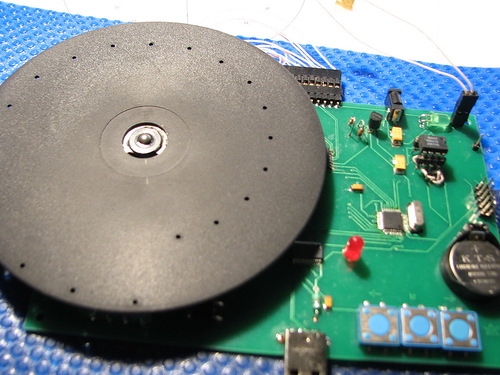
Although [Serokoy] is not thrilled with the outcome of his Nipkow disk clock (translated), but we really enjoy it. It uses the Persistence of Vision concept to create a light display from a rotating disk.
We’ve come across a lot of rotating disk clocks. Several were based off of the platters of a hard drive, using a slit, or series of slits to make up the display. This Nipkow disk uses a similar technique but in a more general way. The series of holes arranged in a spiral pattern allows a grid of concentric rings to be used as pixels when the disk is spinning. The bottom portion of the disk is used as the display area. Each pixel is illuminated at just the right time by LEDs below in order to freeze that pixel in the viewer’s eye. The demo is a bit rough, and [Serokoy] mentions that the precision of the hole layout makes all the difference. He drilled these by hand in a CD which was spray painted matte black. Even though he used a computer to lay out and print a template, it took four tries to get a suitable disk.
[Thanks Svofski]














Nice effort. Too bad those Jandeks videos won’t load, so I can’t see the demo :( He should transfer them to Youtube.
Second! (Motion carries.)
Thirded.
Kinda feeling I’m really missing out here.
Videos work fine for me, perhaps you need to move to a less censored country? Or what?
I so love a Nipkow Disk I’ve been wanting to build camera version, using UV, microwave or IR.
Remember reading about them as child.
Great work!
Videos here for a limited, indeterminate amount of time:
http://dl.dropbox.com/u/19231999/m450x334.flv
http://dl.dropbox.com/u/19231999/m450x334-1.flv
arrrrggg chrome
this gets 10 out of 10 for ingenuity AND badass hackery from me :-)
I had the same idea too for an infrared “pyro camera” but the problem is that most commercial sensors are too small to cover any sort of reasonable area.
For those who wish to experiment, I suggest using a pyroelectric crystal such as lithium tantalate or a polymer like PVDF which can be found in some speakers and those white security tags :)
You can use a lens to focus the light into the small aperture of the sensor. Just pick the right lens that doesn’t absorb the far infrared spectrum. Plastic fresnel lenses are common and widely used on PIR motion sensors.
Regarding the sensor, I just got this one from TI:
http://www.ti.com/product/tmp006&DCMP=hpa-tmp-tmp006&HQS=Tools+PR+tmp006ibis-pr
I’m trying to find some time to make a breakout board for it.
The fresnel lenses from infrared thermometers are also quite cool and have a relatively high focal distance and small aperture ratio.
Additional notes; I am experimenting with this at the moment, more news soon.
seems that reading the capacitance of the PVDF/ITO sandwich using a round robin technique might be feasible, ITO does reflect infrared a bit however its better than nothing.
Possible idea *3, use modwire + ITO as the pickup, as the capacitance change ought to be detectable.
Awesome, I like!
http://en.savefrom.net/?url=http%3A%2F%2Fru-radio-electr.livejournal.com%2F994533.html&_openstat=ext;opera;bmrk;
so you can directly download them, pretty neat project!
Serokoy is indeed great, even good things can be considered a failure